 W
WThe Panamint Range is a short rugged fault-block mountain range in the northern Mojave Desert, within Death Valley National Park in Inyo County, eastern California. Dr. Darwin French is credited as applying the term Panamint in 1860 during his search for the fabled Gunsight Lode. The orographic identity has been liberally applied for decades to include other ranges.
 W
WBallarat is an unincorporated community in Inyo County, California. It lies at an elevation of 1079 feet.
 W
WBarker Ranch is located inside Death Valley National Park in eastern California. Used as a mining and recreational property from the 1940s to the 1960s, it is infamous due to its association with Charles Manson and his "family".
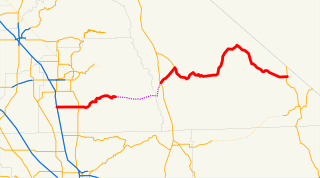 W
WState Route 190 is a state highway in the U.S. state of California that is split into two parts by the Sierra Nevada. The western portion begins at Tipton at a junction with State Route 99 and heads east towards Porterville before ending at Quaking Aspen in the Sequoia National Forest. The eastern portion begins at US 395 at Olancha, heads east through Death Valley National Park, and ends at State Route 127 at Death Valley Junction. The 43.0-mile (69.2 km) portion over the Sierra Nevada remains unconstructed, and the California Department of Transportation (Caltrans) has no plans to build it through the wilderness areas. SR 190 is a National Scenic Byway known as the Death Valley Scenic Byway.
 W
WCalochortus panamintensis is a rare North American species of flowering plants in the lily family known by the common name Panamint mariposa lily. It is native to Inyo and Kern Counties in California, plus adjacent Nye County, Nevada. It is named after the Panamint Range near Death Valley.
 W
WCrotalus stephensi is a venomous pitviper species found in central and southern Nevada and adjacent California. Common names include panamint rattlesnake, panamint rattler, Owens Valley rattler, and tiger rattlesnake.
 W
WDiplacus rupicola, the Death Valley monkeyflower, is a flowering plant in the family Phrymaceae.
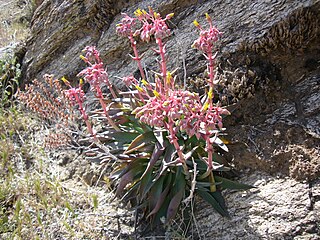 W
WDudleya saxosa is a perennial succulent desert plant in the family Crassulaceae, commonly called live-forever'. This dudleya is native to the rocky slopes of the Peninsular Ranges and the sky islands in Mojave Desert mountains, such as the Panamint Range, in Southern California, and in Baja California and Arizona.
 W
WEnceliopsis covillei, known by the common name Panamint daisy, is a rare North American desert species of flowering plant in the daisy family.
 W
WEriogonum hoffmannii is a species of wild buckwheat known by the common name Hoffmann's buckwheat. It is endemic to Inyo County, California, where it is found only in the mountains around Death Valley; most of the known populations of the plant are located in Death Valley National Park. The plant grows in the desert scrub on the slopes of the Panamint, Black, and Funeral Mountains.
 W
WEriogonum panamintense is a species of wild buckwheat known by the common name Panamint Mountain buckwheat. It is native to several of the desert mountain ranges of eastern California and western Nevada, including the Panamint Range. It grows in various types of mountain ridge habitat, such as sagebrush and coniferous woodland.
 W
WThe Panamint alligator lizard is a species of lizard in the Anguidae family.
 W
WBuddleja utahensis is a species of Buddleja endemic to the southwestern United States, where it is known by the common names Utah butterfly bush and Panamint butterfly bush. Named and described by Coville in 1892, the shrub favours limestone outcrops at elevations of 700–2000 m, where it is often found in association with Joshua trees.
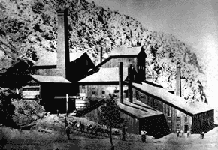 W
WPanamint City is a ghost town in the Panamint Range, near Death Valley, in Inyo County, California, US. It is also known by the official Board of Geographic Names as Panamint. Panamint was a boom town founded after silver and copper were found there in 1872. By 1874, the town had a population of about 2,000. Its main street was one mile (1.6 km) long. Panamint had its own newspaper, the Panamint News. Silver was the principal product mined in the area. The town is located about three miles northwest of Sentinel Peak. According to the National Geographic Names Database, NAD27 latitude and longitude for the locale are 36°07′06″N 117°05′43″W, and the feature ID number is 1661185. The elevation of this location is identified as being 6,280 feet AMSL. The similar-sounding Panamint Springs, California, is located about 25.8 miles at 306.4 degrees off true north near Panamint Junction.
 W
WCryptantha angustifolia is a species of wildflower in the borage family known by several common names, including Panamint catseye and bristlelobe cryptantha. This plant is native to northern Mexico and the Southwestern United States from California to Texas, where it grows in desert scrub and woodland.
 W
WThe Panamint kangaroo rat is a species of rodent in the family Heteromyidae. It is endemic to the Mojave Desert in eastern California and western Nevada, in the United States.
 W
WDudleya saxosa is a perennial succulent desert plant in the family Crassulaceae, commonly called live-forever'. This dudleya is native to the rocky slopes of the Peninsular Ranges and the sky islands in Mojave Desert mountains, such as the Panamint Range, in Southern California, and in Baja California and Arizona.
 W
WCalochortus panamintensis is a rare North American species of flowering plants in the lily family known by the common name Panamint mariposa lily. It is native to Inyo and Kern Counties in California, plus adjacent Nye County, Nevada. It is named after the Panamint Range near Death Valley.
 W
WEriogonum panamintense is a species of wild buckwheat known by the common name Panamint Mountain buckwheat. It is native to several of the desert mountain ranges of eastern California and western Nevada, including the Panamint Range. It grows in various types of mountain ridge habitat, such as sagebrush and coniferous woodland.
 W
WPenstemon floridus is a species of flowering plant in the plantain family known by the common names Panamint beardtongue and rose penstemon.
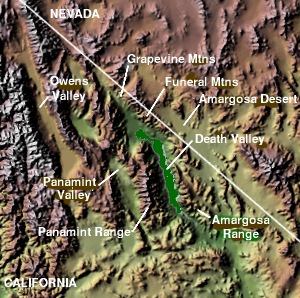 W
WThe Panamint Valley is a long basin located east of the Argus and Slate ranges, and west of the Panamint Range in the northeastern reach of the Mojave Desert, in eastern California, United States.
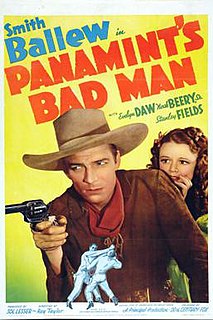 W
WPanamint's Bad Man is a 1938 American Western film directed by Ray Taylor and written by Luci Ward and Charles Arthur Powell. The film stars Smith Ballew, Evelyn Daw, Noah Beery, Sr., Stanley Fields, Harry Woods and Pat J. O'Brien. The film was released on July 8, 1938, by 20th Century Fox.
 W
WPanamintaspis snowi is an extinct species of pteraspidid heterostracan agnathan which existed during the early Middle Devonian period of Death Valley, California. Fossils are found in Late Emsian-aged marine strata of the Lost Burro Formation. P. snowi strongly resembles Pteraspis, though while it was originally described as a member of the same family, Pteraspididae, a recent phylogenetic reassessment of the order Pteraspidiformes places P. snowi within the paraphyletic family "Protopeteraspidae," as the sister taxon of the suborder Pteraspidoidei.
 W
WPenstemon floridus is a species of flowering plant in the plantain family known by the common names Panamint beardtongue and rose penstemon.
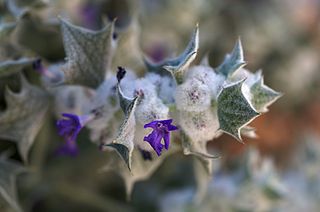 W
WSalvia funerea, with the common names Death Valley sage, woolly sage, and funeral sage, is an intricately branched shrub associated with limestone soils in the Mojave Desert in California and Nevada. It has an overall white appearance due to wooly hairs that cover the stems and leaves.
 W
WSentinel Peak is located in Death Valley National Park near Panamint City, California.
 W
WTelescope Peak is the highest point within Death Valley National Park, in the U.S. state of California. It is also the highest point of the Panamint Range, and lies in Inyo County. From atop this desert mountain one can see for over one hundred miles in many directions, including west to Mount Whitney, and east to Charleston Peak. The mountain was named for the great distance visible from the summit.
 W
WUSS Panamint (AGC-13) was a Mount McKinley-class amphibious force command ship named after the Panamint Range of mountains in California. She was designed as an amphibious force flagship, a floating command post with advanced communications equipment and extensive combat information spaces to be used by the amphibious forces commander and landing force commander during large-scale operations.